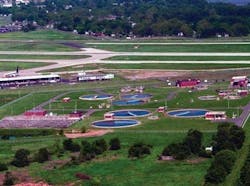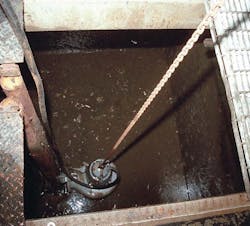The Adams Field Wastewater Treatment Plant (WWTP) receives wastewater from 63,000 homes and businesses. Designed in 1961 for primary treatment, the facility was rated at 36 million gallons per day (mgd) after the addition of secondary treatment in 1972. The plant now handles 70 percent of the sewage generated within the Little Rock Wastewater Utility service area.
Scope
As with many plants modified for activated sludge treatment, the existing infrastructure at the Adams Field facility enabled rags and other debris to clog the two 35-HP and two 15-HP return activated sludge submersible pumps.
“Under normal conditions, the old pumps enabled us to return pump 70 percent of the return sludge from the clarifiers to the aeration tanks. But during a rain event, the relationship of returned sludge to inflow would decrease. A blockage would easily reduce the return flow capacity by 25 to 50 percent.”
As frequently as every two weeks, large clumps of debris would completely clog the impellers. When back-flushing the pumps failed to clear the problem, plant employees had to pull the pumps out of the wetwell to de-rag them by hand. Pulling and clearing the pumps took two men more than an hour, costing the utility an average of $75 to $100 per event.
Solution
Jack Tyler Engineering Company of Arkansas, the local Flygt factory representative, offered the utility a chance to field test a new generation of RAS submersible pumps equipped with the revolutionary Flygt N-technology impeller. One of the plant’s two 15-horsepower pumps was replaced with a Flygt prototype rated at 18-HP.
The technologically advanced impeller is engineered to prevent clogging and improve operational efficiency. The hydraulic end of the pump features a patented self-cleaning impeller, the key to the equipment’s reliability and ease of maintenance over long operating periods. The prototype pump was installed with the intent to run it only four months, but the factory representative was so confident about the Flygt N-technology that the supplier asked the utility to run the test pump until it failed before pulling it from service.
“We finally pulled the experimental pump after 18 months to conduct the first inspection,” Hyke said. “It was still working fine and had never clogged or had a motor failure. During that time, however, the other three pumps continued to experience clogging on a daily basis.”
Result
The prototype was sent back to Flygt for engineering study, and the plant received four new pumps: two 25-HP Model N 3201 pumps, and two 12-HP Model N 3152 submersibles, all equipped with the advanced impellers and variable frequency drives (VFD). Flygt pumps equipped with N-technology impellers and VFDs have been proven to deliver significant reductions in energy usage, and according to Hyke, the replacements have fully met performance expectations.
“I have an elevation point set in the return pump station wetwell and maintain a constant flow from the clarifier suction tubes, and there is never any clogging of the pumps,” Hyke said. “The new pumps with variable frequency drives gave me the capability to set my flow based on 60 Hz down to 30 Hz.”
“The new N-technology impellers have all but eliminated the clogging problem, simply by pumping away any debris that passes through the system and reaches the pump intakes.”
Editor's Note: Scranton Gillette Communications and the SGC Water Group are not liable for the accuracy, efficacy and validity of the claims made in this piece. The views expressed in this content do not reflect the position of the editorial teams of Water & Wastes Digest, Water Quality Products and Storm Water Solutions.

